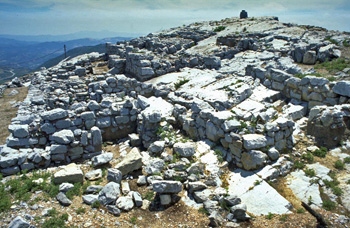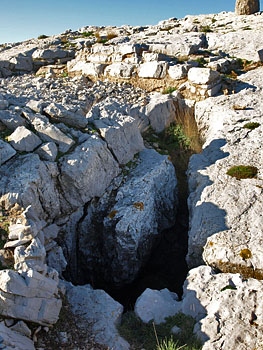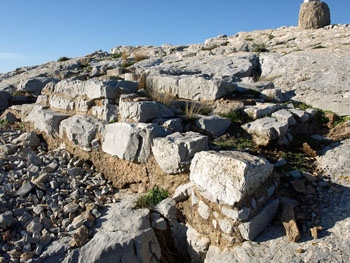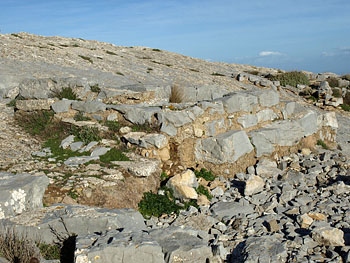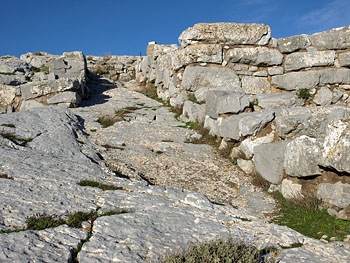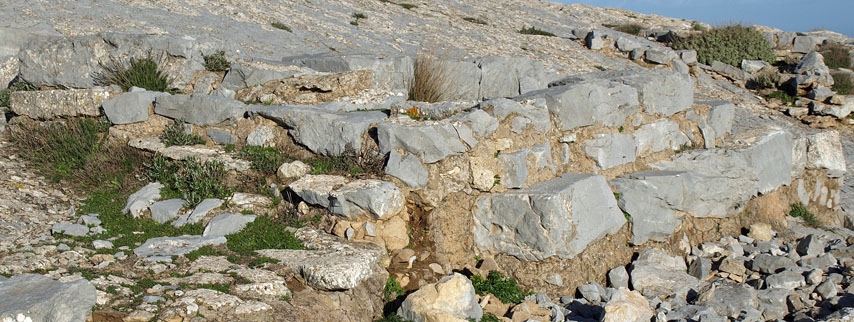
A creation of the Middle Minoan period
Peak Sanctuaries were a phenomenon dating from the Middle Minoan I period. The peak santuary on Juktas served the Minoan palace of Knossos. It was probably built in the MM IA period around 2100 BCE, and was first excavated by Arthur Evans in 1909.
The Juktas Peak Sanctuary, also known as Psili Korfi, is located 13 kilometres south-west of Knossos, from where the mountain peak can be seen. To the east of the sanctuary lies the village of Archanes, which was the site of a major Minoan settlement, possibly including a palace. Unfortunately the modern village was built on top of the Minoan site so a complete excavation has proved impossible. When Arthur Evans excavated the Juktas site he uncovered what he considered to be a priest's house of the early Aegeo-Cretan "but and ben" type.
Reinterpretation
Excavations at the site were re-commenced in 1974 and conducted by Alexandra Karetsou, whose article in "Sanctuaries-Cults in the Aegean Bronze Age" provides the basis for this account. It very soon emerged that what Evans had called a priest's house had, in fact, been the main part of the open air sanctuary which consists of two stepped terraces, oriented north-south. These are reached from the ramp which Evans identified, lying directly to the south.
On the west side of the terraces there is an altar of which the preserved remains measure 4.7 metres long and 50 centimetres high. The altar was built on the edge of one of a number of fissures on the top of the mountain. This particular fissure has been excavated to a depth of ten metres (but not to the bottom) and produced a large number of interesting finds.
To the east of Terrace II, a series of fives rooms was found, running south to north. These rooms were probably not central to the worship that was conducted at the shrine. The northern part of the site remains to be fully excavated. Unfortunately the national telephone company built a radar station within the Peak Sanctuary site in 1952, probably destroying the Minoan remains in this area. A possible third terrace exists to the east of the series of rooms, and this, too, awaits investigation.
The terraces were built either at the end of the Old Palace period or at the beginning of the New Palace period. The majority of sherds in terrace I come from MM I-II. The existence of MM IA sherds in the deepest fissures of the rocks all over the peak suggest a sanctuary of the prepalatial period or the existence of other, early religious practices on this site.
The excavator of the site concluded that the peak sanctuary was the public open-air sactuary of the Knossos area in the Old Palace period. In MM III however, when the new palaces were built, the connection with the Palace of Knossos becomes clearer because the architectural remains are monumental when compared with other peak sanctuaries that have been excavated. Also, the quality of the finds has a palatial character.
The sanctuary is enclosed by a wall of genuine cyclopean construction. The wall is 735 metres long and over three metres wide. It is about 3.5 metres high. One strange fact about the wall is that on the south and east sides, the wall is very close to the Minoan sanctuary, but its north side, where the entrance is to be found, is 410 metres away from the sanctuary. This raises the question of whether the wall is in fact the temenos wall of the sanctuary or not. Various dates have been proposed for the building of the wall from MM IA to LM III, but the only evidence to come to light so far has been an offering table dating to the MM III/LM I periods which had been built into the wall.
Which deities were worshipped?
It is not known what gods or goddesses were worshipped at the peak sanctuaries. The Mountain Mother and her young male god/companion who is called either Velchanos or Hyakinthos have been written about by Evans and Nilsson among others. It is possible that the site may be linked to the new-born child Dias or Zeus. Originally he may have been the spirit of the wealth of the earth, although mythology was to assign to him a different role under the Ancient Greeks.
N. Platon believed that the peak sanctuary was a royal sanctuary because of the quantity of previous material found there. He believed that the Archanes buildings were connected to the sanctuary in some way. There was even a road joining the two. Platon believed that the building excavated by A. Karetsou on Iuktas corresponded to the tripartite shrines represented on vases. The rooms in front of the terrace would correspond to the front rooms of these tripartite shrines.
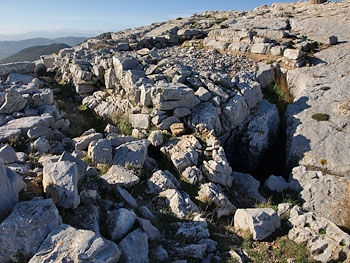
View of the site. The fissure is in the foreground right with the altar behind. Terrace II is to the left of the fissure and the narrow Terrace I is below Terrace II. (Click pic for larger photo)
Peter Warren has emphasised the long period during which the shrine was in use, arguing that this points to the continuity of the Minoan religion. He also pointed out that the presence of the the fissure next to the altar links the peak sanctury cult to the cave sanctuary cult as integral parts of Minoan religion.
Access
The Juktas Peak Sanctuary is reached by an appalling dirt track which winds up the side of Mount Iuktas for five kilometres. The turning to the right is to be found, signposted, several kilometres south of the village of Archanes on the road towards the archaeological site of Vathypetro. The Sanctuary is fenced off but there is usually a gap in the fence somewhere. If you are unlucky, the site can still be seen from outside the fence and the views over Archanes and towards eastern Crete from one side and towards Psiloritis and the west from the other side of the peak are absolutely spectacular.


